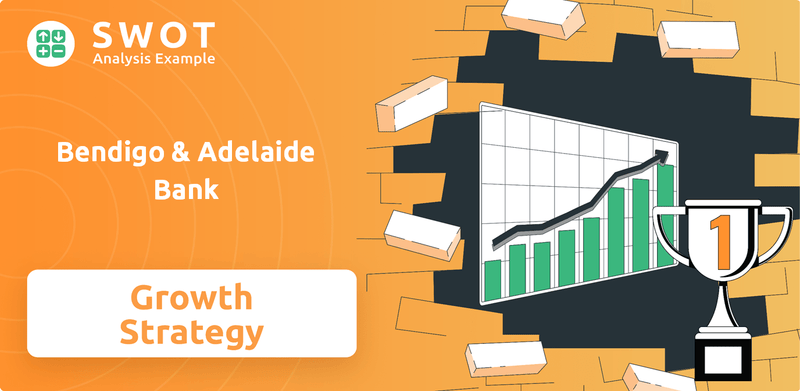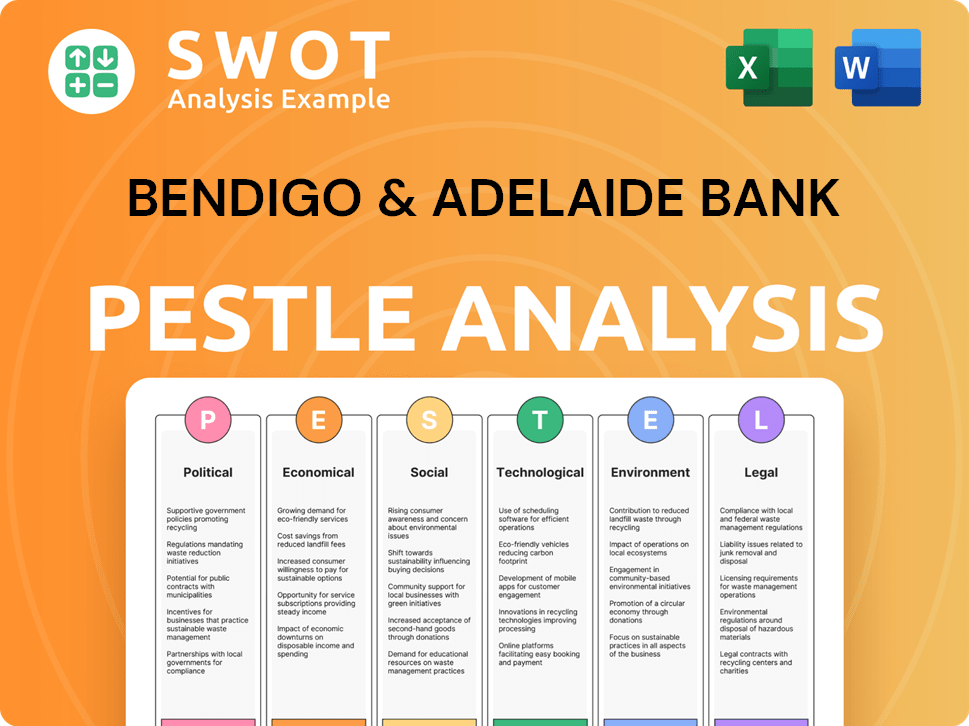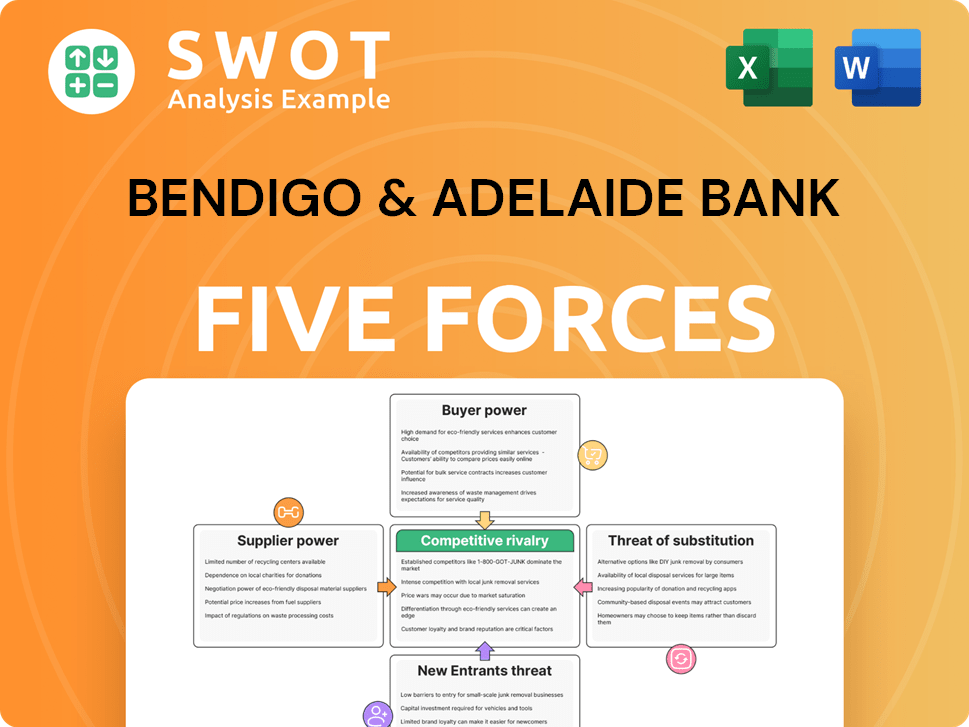Bendigo & Adelaide Bank Bundle
Can Bendigo and Adelaide Bank Sustain Its Growth Trajectory?
Bendigo and Adelaide Bank is undergoing a significant transformation, with a multi-year program set to conclude in 2025, promising streamlined operations and enhanced digital capabilities. This evolution, rooted in a rich history of community focus, now sees the bank navigating the complexities of the modern Bendigo & Adelaide Bank SWOT Analysis. With a commitment to being 'Australia's better big bank,' the company is poised for further expansion and innovation.

This exploration of Bendigo Adelaide Bank's Growth Strategy will examine its strategic initiatives, technological advancements, and financial outlook, offering crucial insights for investors and stakeholders. Understanding the Bank Future Prospects requires a deep dive into its operational efficiency and customer-centric approach within the competitive Banking Industry. Analyzing the bank's Financial Performance and strategic planning is key to forecasting its long-term success and assessing its potential within the current economic climate.
How Is Bendigo & Adelaide Bank Expanding Its Reach?
The Bendigo Adelaide Bank is actively pursuing several expansion initiatives as part of its Growth Strategy, focusing on both organic growth and strategic consolidation to enhance its Bank Future Prospects. These initiatives are designed to strengthen its position within the Banking Industry and improve its Financial Performance.
A key element of the bank's strategy involves leveraging its existing strengths while embracing new technologies and customer-centric approaches. The bank's approach includes a focus on residential lending, digital banking, and community engagement. These initiatives are supported by a robust Strategic Planning framework aimed at achieving sustainable growth and maximizing shareholder value.
The bank's commitment to innovation and customer service, coupled with its strong community ties, positions it well for future success in a competitive market. The bank aims to capitalize on emerging opportunities while mitigating risks, ensuring long-term value creation for its stakeholders.
Residential lending is a significant area of expansion for the bank. Over the half-year ending December 2024, residential lending saw a 5.3% increase. This contributed to a total lending growth of 3.4%. The residential loan book reached $65.2 billion at the end of December 2024.
Digital mortgage offerings are a key component of the bank's strategy. Digital platforms, including those from Up and Tiimely, accounted for 19% of all new settled mortgages in the half-year ending December 2024. This highlights the bank's commitment to digital transformation.
The bank continues to invest in Up, its digital neobank. Up has surpassed 1 million customers after six years of operation. Customer growth for Up was 13.2% half-on-half. Deposits increased by 22.6% to $2.6 billion, and home loans increased to $1.2 billion.
The migration of Rural Bank customers to Bendigo Bank Agribusiness is set to be completed in the second half of fiscal year 2025. This integration streamlines operations and improves customer experience for micro-business customers. The Business Direct team has been established to support this initiative.
The bank leverages its strong community connections and the Community Bank model to support growth and enhance customer engagement. In FY24, the Community Bank model reinvested $40.3 million into Australian communities. This model is a key element of the bank's Bendigo Adelaide Bank growth initiatives.
- The Bendigo Lending Platform facilitated home lending growth at twice the system rate.
- The platform is being extended to mobile lenders and branches in the current calendar year.
- These initiatives contribute to the bank's overall Financial Performance.
- The bank's expansion plans are designed to enhance its Market Share Analysis.
Bendigo & Adelaide Bank SWOT Analysis
- Complete SWOT Breakdown
- Fully Customizable
- Editable in Excel & Word
- Professional Formatting
- Investor-Ready Format

How Does Bendigo & Adelaide Bank Invest in Innovation?
The innovation and technology strategy is a cornerstone of the Bendigo Adelaide Bank's growth strategy. This strategy is designed to modernize infrastructure and improve customer experience. The bank is investing heavily in digital transformation to achieve its objectives.
The bank's strategic planning includes a multi-year transformation program, with completion expected by the end of 2025. A central goal is to consolidate operations onto a single core banking system. This move is expected to streamline processes and reduce operational complexities.
Bendigo Adelaide Bank is focused on enhancing its Bank Future Prospects through strategic technology investments and innovation. The bank is leveraging cutting-edge technologies to improve efficiency and customer service.
The bank is consolidating its core banking systems to reduce complexity and modernize its infrastructure. This initiative aims to streamline operations and improve efficiency. The goal is to operate on a single core banking system by late 2025.
The digital transformation includes transitioning to cloud services and reusing APIs to streamline services across its brands. This approach aims to improve customer experience and operational efficiency. The digital bank, Up, serves as a testing ground for new ideas.
The bank is leveraging AI to rewrite legacy applications and support its transition to an AI-enabled cloud infrastructure. A partnership with MongoDB utilized generative AI to reduce development time for migrating a core banking application by up to 90%. This has significantly accelerated innovation.
The successful roll-out of the Bendigo Lending Platform has supported home lending growth. This platform is being deployed to mobile lenders and branches in 2025. This platform is designed to enhance lending processes.
The bank is implementing a market-leading CRM and origination platform from Salesforce and nCino. This platform is for its business and agribusiness segments. A new origination platform is set to be operational before the end of the 2024 calendar year.
Continued investments in digital deposit capabilities and process automation are underway to enhance customer experience. These investments aim to improve efficiency and contribute to growth objectives. This includes streamlining various banking processes.
The Bendigo Adelaide Bank's technology investments are designed to drive Financial Performance and support its Strategic Planning. These advancements are crucial for the Bank Future Prospects.
- The consolidation of core banking systems has reduced the number of core banking systems from eight to four.
- IT applications have been reduced by over 38% since FY19.
- The use of generative AI has reduced development time by up to 90% for migrating a core banking application.
- Application test case running time has been reduced from over 80 hours to just five minutes.
- The Bendigo Lending Platform is being deployed to mobile lenders and branches in 2025.
For more insights into the Bendigo Adelaide Bank's business model and revenue streams, you can read this article: Revenue Streams & Business Model of Bendigo & Adelaide Bank.
Bendigo & Adelaide Bank PESTLE Analysis
- Covers All 6 PESTLE Categories
- No Research Needed – Save Hours of Work
- Built by Experts, Trusted by Consultants
- Instant Download, Ready to Use
- 100% Editable, Fully Customizable

What Is Bendigo & Adelaide Bank’s Growth Forecast?
The financial outlook for Bendigo Adelaide Bank is shaped by its ongoing transformation program and strategic growth initiatives. The bank's performance in the half-year ending December 31, 2024, reflects both challenges and strengths within the Banking Industry. The bank's ability to navigate margin pressures and invest in digital capabilities will be crucial for its future success. Understanding the Bendigo Adelaide Bank growth initiatives is key to assessing its trajectory.
For the half-year ending December 31, 2024, the bank reported cash earnings of $265.2 million, a decrease of 1.1% on the prior comparative period, and a statutory net profit after tax of $216.8 million, down 23.2% year-over-year. These figures highlight the impact of margin pressures and increased expenses due to investments in the transformation program. Despite these headwinds, the bank maintains a strong balance sheet and focuses on strategic planning for future growth.
The bank's balance sheet remains robust, with a Common Equity Tier 1 (CET1) ratio of 11.17% as of December 2024. Customer deposits grew by 5.4% over the half, reaching $72.0 billion. Total lending grew by 3.4% over the half, with residential lending increasing by 5.3%. These figures show the bank's ability to attract deposits and grow its lending portfolio, which is essential for long-term financial health. For a deeper understanding of the bank's origins, you can read a Brief History of Bendigo & Adelaide Bank.
Cash earnings for the half-year ending December 31, 2024, were $265.2 million, a decrease of 1.1%. Statutory net profit after tax was $216.8 million, down 23.2% year-over-year. These figures reflect the impact of margin pressures and increased expenses.
The bank maintains a strong balance sheet, with a Common Equity Tier 1 (CET1) ratio of 11.17% as of December 2024. Customer deposits grew by 5.4%, reaching $72.0 billion, and total lending grew by 3.4%.
The bank aims to achieve a return to growth in its Business and Agribusiness segment in FY26 and maintain Up's current growth trajectory. It targets a reduction in its cost-to-income ratio towards 50%.
Management anticipates increasing investment spending in FY25 and FY26 by $30-40 million on FY24 levels to enhance digital capabilities. Single-digit loan growth and stable net interest margins are expected in FY25.
The bank's strategic initiatives and investment in digital capabilities are key to its Bank Future Prospects. The bank anticipates single-digit loan growth and stable net interest margins in fiscal year 2025. Fitch Ratings expects the bank's core metric of operating profit/risk-weighted assets to remain around 1.8%.
- Focus on Business and Agribusiness segment growth in FY26.
- Targeting a cost-to-income ratio reduction.
- Increasing investment in digital capabilities.
- Anticipated single-digit loan growth in FY25.
Bendigo & Adelaide Bank Business Model Canvas
- Complete 9-Block Business Model Canvas
- Effortlessly Communicate Your Business Strategy
- Investor-Ready BMC Format
- 100% Editable and Customizable
- Clear and Structured Layout

What Risks Could Slow Bendigo & Adelaide Bank’s Growth?
The Bendigo Adelaide Bank faces several potential risks that could influence its Growth Strategy and Bank Future Prospects. These challenges span market competition, regulatory changes, operational issues, and economic factors. Understanding these risks is crucial for evaluating the bank's long-term financial health and strategic direction within the Banking Industry.
Intense competition, particularly in the residential mortgage sector, can limit the bank's net interest margins. Furthermore, regulatory changes and increased scrutiny contribute to higher compliance costs. Operational risks, including those related to technology and data security, also pose a threat. These factors require careful management and strategic planning to ensure sustained Financial Performance.
Economic conditions, such as higher interest rates and inflation, can pressure households, potentially increasing impaired loans. The bank's ongoing transformation program, while essential for future growth, introduces the risk of increased costs or service disruptions if not implemented effectively. To address these risks, the bank must maintain a strong capital position and focus on disciplined cost management.
The Banking Industry is highly competitive, especially in the residential mortgage sector. This competition can squeeze net interest margins, affecting the Financial Performance of Bendigo Adelaide Bank. The bank's net interest margin was down 6 basis points to 1.88% in the half-year ending December 2024, highlighting the impact of increased funding costs and competitive pressures.
Bendigo Adelaide Bank must navigate regulatory changes and increased scrutiny, which drive up compliance costs. These costs require significant investments in technology and risk management. Failure to adapt to these changes can lead to penalties and reputational damage, impacting the bank's Strategic Planning.
Operational risks, including those from internal processes, people, systems, and external events, are a concern. This includes risks related to regulatory compliance, financial crime, and data security. Effective management of these risks is critical for maintaining customer trust and operational efficiency, which are key to the Bank Future Prospects.
Economic conditions, such as higher interest rates and persistent inflation, can pressure households. This can lead to an increase in impaired loans. While Bendigo Adelaide Bank anticipates a rise in impaired loans, it expects this to be manageable due to conservative underwriting standards. Understanding these economic impacts is vital for Strategic Planning.
The bank's ongoing transformation program, although crucial for future growth, carries risks. These include increased project costs and potential delays in compliance. Effective execution of this program is essential to avoid disruptions in customer service and maintain a competitive edge, influencing Bendigo Adelaide Bank growth initiatives.
Bendigo Adelaide Bank mitigates these risks through a strong capital position, with a Common Equity Tier 1 ratio consistently above regulatory requirements. It also focuses on disciplined cost management and maintaining a low-risk profile. These strategies are crucial for ensuring the Bank Future Prospects and long-term sustainability.
Bendigo Adelaide Bank maintains a strong capital position to absorb potential losses. The bank's Common Equity Tier 1 ratio is a key indicator of its financial strength. The bank's focus on disciplined cost management is also crucial. This commitment helps manage expenses effectively, supporting the bank's Financial Performance and Bendigo Adelaide Bank market share analysis.
Bendigo Adelaide Bank focuses on residential mortgages and maintains consistent underwriting standards to manage its risk profile. This approach helps the bank maintain a competitive advantage in the market. A clear focus on core competencies and a commitment to prudent risk management are essential elements of the Bendigo Adelaide Bank investment strategy.
For more insight into the values guiding the bank, read about the Mission, Vision & Core Values of Bendigo & Adelaide Bank.
Bendigo & Adelaide Bank Porter's Five Forces Analysis
- Covers All 5 Competitive Forces in Detail
- Structured for Consultants, Students, and Founders
- 100% Editable in Microsoft Word & Excel
- Instant Digital Download – Use Immediately
- Compatible with Mac & PC – Fully Unlocked

Related Blogs
- What are Mission Vision & Core Values of Bendigo & Adelaide Bank Company?
- What is Competitive Landscape of Bendigo & Adelaide Bank Company?
- How Does Bendigo & Adelaide Bank Company Work?
- What is Sales and Marketing Strategy of Bendigo & Adelaide Bank Company?
- What is Brief History of Bendigo & Adelaide Bank Company?
- Who Owns Bendigo & Adelaide Bank Company?
- What is Customer Demographics and Target Market of Bendigo & Adelaide Bank Company?
Disclaimer
All information, articles, and product details provided on this website are for general informational and educational purposes only. We do not claim any ownership over, nor do we intend to infringe upon, any trademarks, copyrights, logos, brand names, or other intellectual property mentioned or depicted on this site. Such intellectual property remains the property of its respective owners, and any references here are made solely for identification or informational purposes, without implying any affiliation, endorsement, or partnership.
We make no representations or warranties, express or implied, regarding the accuracy, completeness, or suitability of any content or products presented. Nothing on this website should be construed as legal, tax, investment, financial, medical, or other professional advice. In addition, no part of this site—including articles or product references—constitutes a solicitation, recommendation, endorsement, advertisement, or offer to buy or sell any securities, franchises, or other financial instruments, particularly in jurisdictions where such activity would be unlawful.
All content is of a general nature and may not address the specific circumstances of any individual or entity. It is not a substitute for professional advice or services. Any actions you take based on the information provided here are strictly at your own risk. You accept full responsibility for any decisions or outcomes arising from your use of this website and agree to release us from any liability in connection with your use of, or reliance upon, the content or products found herein.